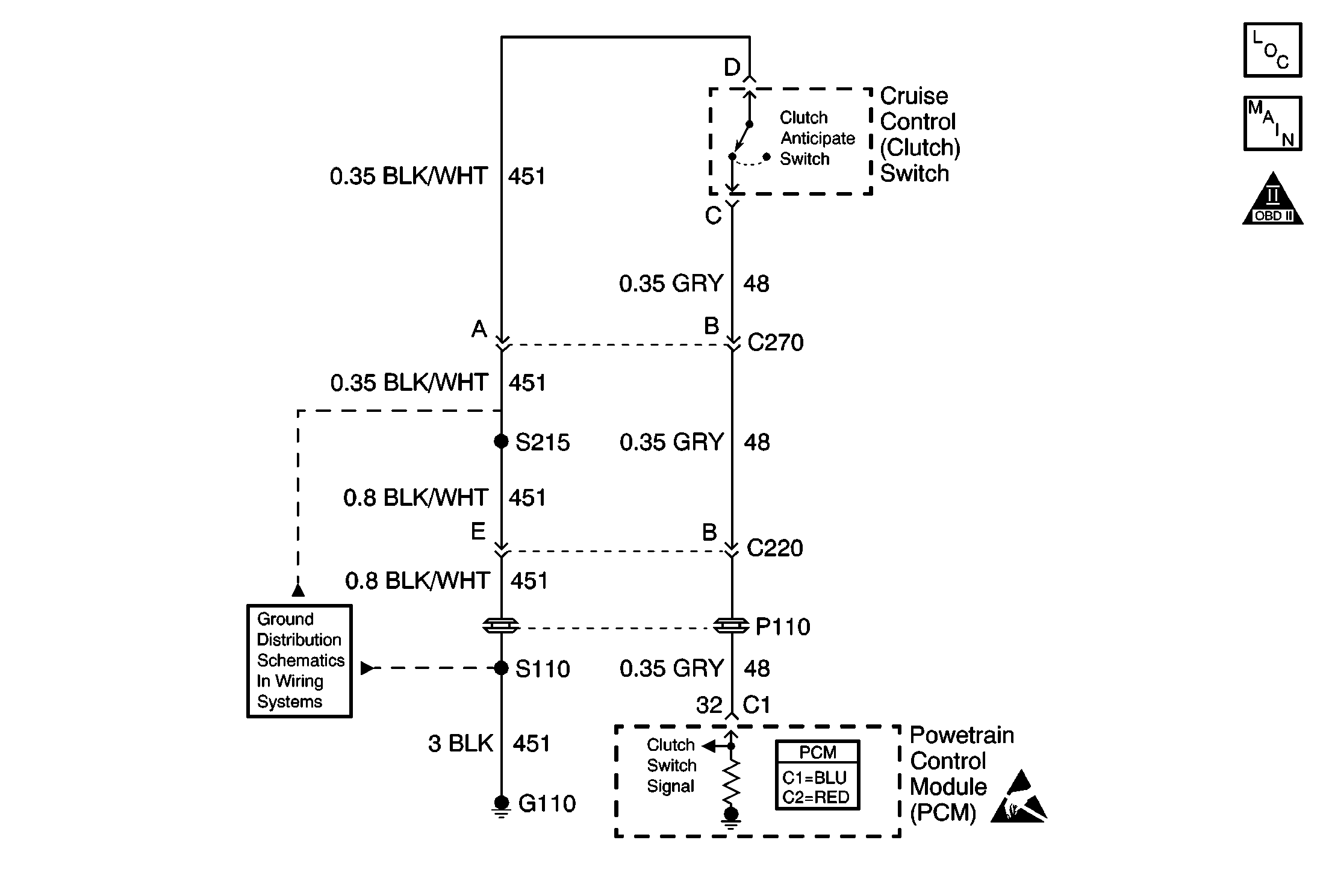
Circuit Description
The Clutch Anticipate Switch is a normally closed switch. The PCM applies a voltage (B+) to the Clutch Anticipate Switch circuit. When the Clutch Anticipate Switch is depressed (clutch pedal released) the circuit is open and the PCM senses a high voltage. When the Clutch Anticipate Switch is released (clutch pedal depressed) the Clutch Switch contacts close, causing the applied voltage to go low.
The PCM determines if the Clutch Anticipate Switch has failed by not sensing a clutch switch transition. The PCM monitors vehicle speed from 0 to a predetermined speed.
Conditions for Running the DTC
No VSS DTCs.
Conditions for Setting the DTC
| • | Vehicle speed goes from 0 mph to more than 24 mph and back to 0 mph for 2 seconds without the PCM detecting a clutch transition. |
| • | This occurs 7 times before the diagnostic reports a fault. |
Action Taken When the DTC Sets
| • | The powertrain control module (PCM) stores the DTC information into memory when the diagnostic runs and fails. |
| • | The malfunction indicator lamp (MIL) will not illuminate. |
| • | The PCM records the operating conditions at the time the diagnostic fails. The PCM stores this information in the Failure Records. |
Conditions for Clearing the DTC
| • | A last test failed, or current DTC, clears when the diagnostic runs and does not fail. |
| • | A history DTC will clear after 40 consecutive warm-up cycles, if no failures are reported by this or any other non-emission related diagnostic. |
| • | Use a scan tool in order to clear the DTC. |
Diagnostic Aids
Important:
• Remove any debris from the PCM connector surfaces before servicing the PCM. Inspect the PCM connector gaskets when diagnosing/replacing the PCM. Ensure that the gaskets are installed correctly. The gaskets prevent contaminate
intrusion into the PCM. • For any test that requires probing the PCM or a component harness connector, use the
J 35616
connector test adapter kit. Using this kit prevents damage to the harness/component
terminals. Refer to
Using Connector Test Adapters
in Wiring Systems.
For an intermittent condition, refer to Symptoms .
Test Description
The numbers below refer to the step numbers on the diagnostic table.
Step
| Action | Value(s) | Yes | No |
|---|---|---|---|---|
1 | Did you perform the Powertrain On-Board Diagnostic (OBD) System Check? | -- | ||
Does the scan tool display change states when the clutch pedal is depressed and released? | -- | Go to Diagnostic Aids | ||
3 | Inspect the adjustment of the clutch anticipate switch. Refer to Clutch Anticipate Switch Replacement in Clutch. Was an adjustment necessary? | -- | ||
4 |
Does the DMM display the specified voltage? | B+ | ||
5 |
Does the scan tool display the Clutch Switch Released? | -- | ||
6 | Test the continuity of the clutch pedal signal circuit using the DMM connected to ground. Refer to Testing for Continuity in Wiring Systems. Does the DMM display continuity? | -- | ||
7 |
Does the DMM display continuity? | B+ | ||
8 | Test the continuity of the clutch pedal ground circuit using the DMM. Refer to Testing for Continuity in Wiring Systems. Does the DMM display continuity? | -- | ||
9 |
Did you correct the condition? | -- | ||
10 |
Did you correct the condition? | -- | ||
11 | Repair the clutch switch signal circuit. Refer to Wiring Repairs in Wiring Systems. Is the action complete? | -- | -- | |
12 | Repair the clutch switch ground circuit. Refer to Wiring Repairs in Wiring Systems. Is the action complete? | -- | -- | |
13 | Replace the clutch switch. Refer to Clutch Anticipate Switch Replacement in Clutch. Is the action complete? | -- | -- | |
14 |
Important:: Program the replacement PCM. Refer to Powertrain Control Module Replacement/Programming . Replace the PCM. Is the action complete? | -- | -- | |
15 |
Does the scan tool indicate that this test ran and passed? | -- | ||
16 | Select the Capture Info option and the Review Info option using the scan tool. Are any DTCs displayed that you have not diagnosed? | -- | Go to the applicable DTC table | System OK |
